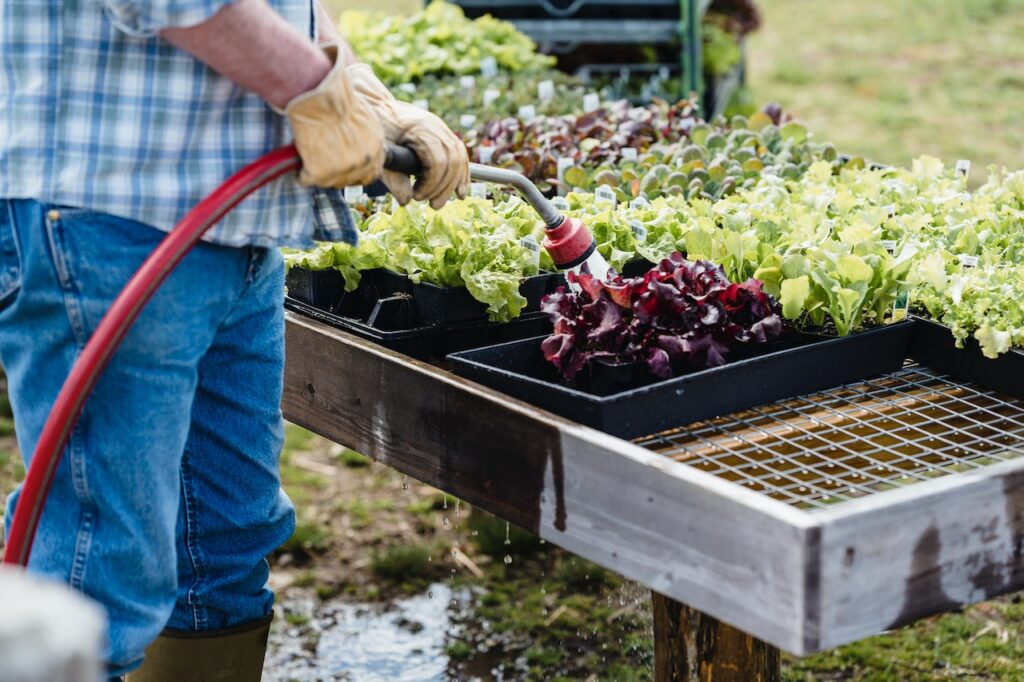Balcony gardens, where small spaces bloom with endless possibilities! Have you ever dreamed of cultivating your own green oasis, even in the heart of a bustling city? Your balcony, no matter how tiny, holds the potential to transform into a lush sanctuary teeming with life and color.
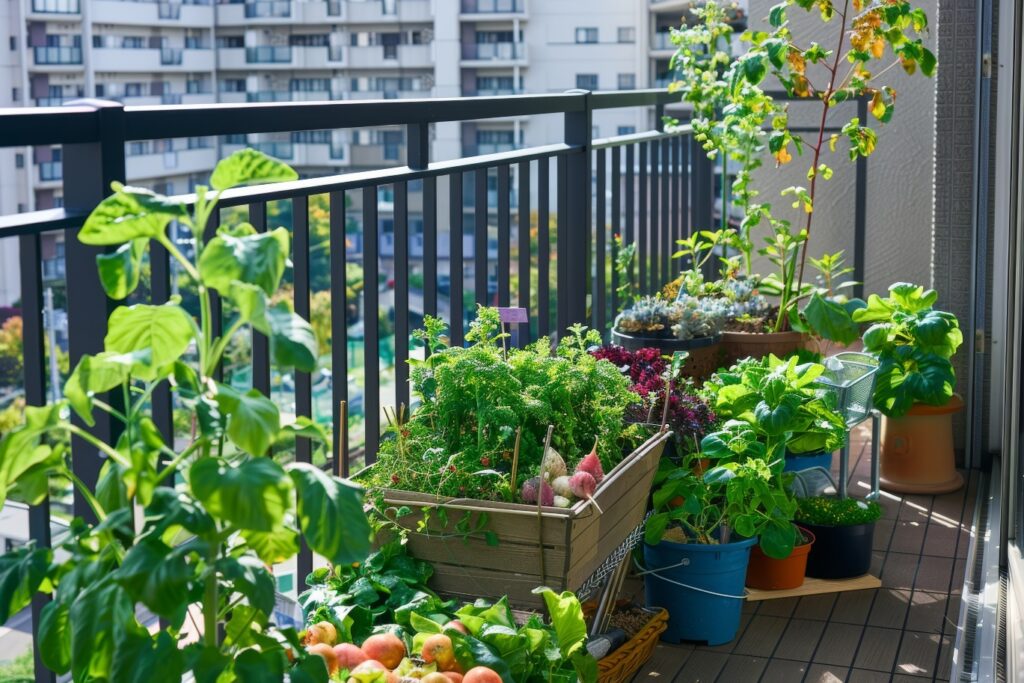
Table of Contents
What’s So Great About Balcony Gardens
Balcony gardens are a game-changer for urban dwellers and those with limited outdoor space. They offer a unique opportunity to create your own green oasis, even in the heart of a bustling city. The beauty of balcony gardening lies in its versatility and the numerous benefits it brings to your life.
One of the biggest advantages of a balcony garden is the convenience it offers. You can easily access your plants right outside your door, making it simple to tend to them regularly. This accessibility allows you to enjoy fresh herbs, vegetables, and flowers without the need for a large yard or frequent trips to the store.
Balcony gardens are also incredibly flexible. You can use a variety of containers, from traditional pots to repurposed items like old watering cans or wood crates, to create a unique and personalized space. This flexibility extends to plant choices as well. Whether you want to grow herbs for cooking, vegetables for fresh produce, or flowers for a splash of color, your balcony garden can accommodate your preferences.
Another great aspect of balcony gardening is its ability to maximize limited space. By using vertical gardening techniques, hanging baskets, and clever container arrangements, you can transform even the smallest balcony into a lush, green retreat. This efficient use of space allows you to grow a surprising amount of plants in a compact area.
Balcony gardens also have a positive impact on your well-being. Gardening is a known stress-reliever, and having a green space right outside your home can provide a peaceful retreat from the hustle and bustle of daily life. The act of caring for plants and watching them grow can be incredibly calming and satisfying.
Balcony gardens also contribute to personal and environmental sustainability. By growing your own herbs and vegetables, you reduce the need for store-bought produce which cuts down on packaging waste and transportation emissions. It also makes you more self-sufficient and less reliant on these sometimes unreliable food systems.
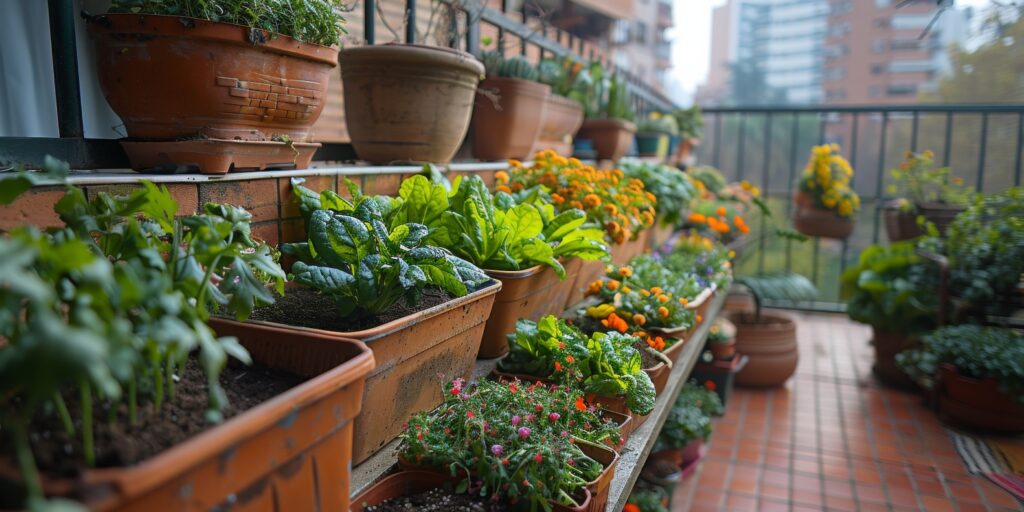
Planning Your Balcony Garden
Before you start your balcony garden, it’s crucial to plan your layout carefully. This will help you make the most of your small space and ensure your plants thrive.
Sun and Wind
Understanding your balcony’s microclimate is essential for a successful garden. Take note of how much sunlight your balcony receives throughout the day. You can use websites like SunCalc to visualize the sun’s trajectory near your home. This will help you position your planters for maximum sun exposure and place shade-tolerant plants in areas with less light.
Wind can be a significant challenge for balcony gardens, especially in high-rise buildings. Strong gusts can damage plants and quickly dry out soil. Consider creating a windbreak using mesh or slatted screens to protect your plants. Alternatively, you can use wind-tolerant plants like Mondo Grass, Japanese Anemone, or Bamboo.
Weight Capacity
Before loading up your balcony with plants, it’s crucial to check its weight capacity. Most residential balconies can support around 40-60 pounds per square foot, but this can vary.
When choosing containers, opt for lightweight options like plastic or fiberglass. These are ideal for balcony gardens as they’re lighter than terracotta or ceramic pots. Spread your pots around the balcony instead of clumping them in one area to distribute the weight evenly.
Planting Plan
When deciding what to grow, consider your balcony’s aspect (north, south, east, or west-facing). This will determine the types of plants that will thrive in your space. The direction your balcony faces plays a crucial role in determining which plants will thrive:
- South-facing balconies receive the most sunlight, perfect for vegetables and sun-loving plants.
- West-facing balconies get afternoon sun, suitable for heat-tolerant plants.
- East-facing balconies receive gentle morning sun, ideal for tender plants and herbs.
- North-facing balconies get limited direct sunlight, best for shade-loving plants like ferns and ivy.
Choosing the Right Plants for Your Balcony
Let’s explore some options for different balcony environments.
Sun-loving Plants
For sunny balconies, you have a wide range of choices. Petunias are popular for their colorful flowers and delightful scent. They’re relatively drought-tolerant but need regular watering in pots. Geraniums are another excellent option, offering bright blooms in various shades. They thrive in direct sunlight and are easy to care for, making them perfect for balcony gardening beginners.
If you’re interested in edibles, consider herbs like rosemary, thyme, and sage. These Mediterranean herbs love sun-drenched spots and are perfect for a small balcony herb garden. For a touch of the exotic, dwarf citrus trees can transform your balcony into a mini orchard.
Shade-tolerant Plants
Don’t worry if your balcony doesn’t get much sun – there are plenty of plants that thrive in shade. Impatiens are a great choice, producing bright flowers all season long. Fuchsias, with their elegant hanging blooms, add a touch of grace to any shaded balcony.
For foliage interest, consider hostas. These plants come in a variety of sizes and colors, and they’re less likely to be bothered by slugs on a balcony. Ferns are another excellent option, bringing a lush, woodland feel to your space.
Wind-resistant Plants
For windy balconies, look for plants with strong stems and small or narrow leaves. Ornamental grasses are a great choice and add movement and texture to your balcony garden. Lavender is another wind-tolerant plant that brings both beauty and fragrance.
Remember, the key to a thriving balcony garden is choosing plants that suit your specific conditions. With the right selection, you can create a beautiful and thriving outdoor space, no matter the size or location of your balcony.
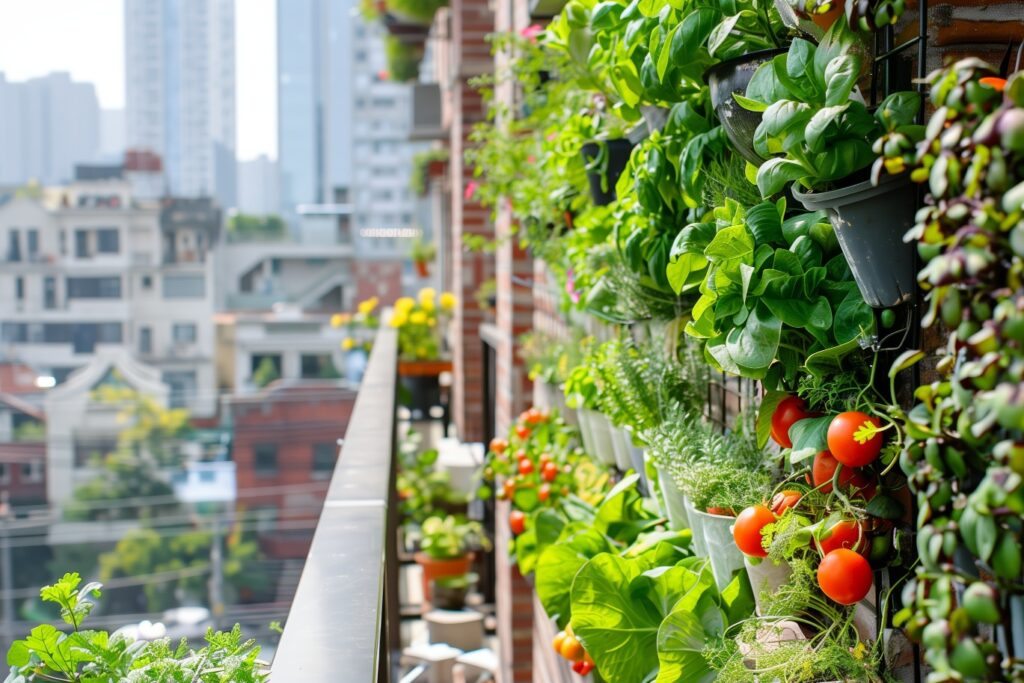
Essential Container Gardening Tips
Selecting the Right Containers
When starting your balcony garden, choosing the right containers is crucial. Opt for pots that are at least 10 inches in diameter to give your plants enough room to grow. Plastic or glazed ceramic containers are excellent choices as they retain moisture better than terra cotta or metal pots. Make sure your containers have drainage holes to prevent waterlogging. For a space-efficient option, consider window planters that can be attached to railings or walls. Growing tables are perfect for those planning to grow vegetables, offering a larger area for diverse plantings.
Using Quality Potting Soil
The foundation of a thriving balcony container garden lies in using high-quality potting soil. Look for mixes containing peat moss, perlite, and vermiculite. These ingredients provide excellent moisture retention, aeration, and nutrient-holding capacity. Avoid using garden soil in your containers as it may contain weed seeds or harmful pathogens. For acid-loving plants, consider using a peat moss-based mix. Remember, good potting soil acts as a reservoir for water and nutrients while providing adequate air space for healthy root growth.
Proper Watering Techniques
Watering is a critical aspect of maintaining your balcony garden. Always water the soil directly, avoiding the leaves to prevent sunburn and fungal diseases. The best time to water is early morning because that allows plants to absorb moisture throughout the day. Before watering, check the soil moisture by inserting your finger about an inch deep. If it feels dry, it’s time to water. When you do water, do so thoroughly until you see water flowing from the drainage holes. This ensures deep root growth and overall plant health.
Maximizing Space with Vertical Gardening
Vertical gardening is a game-changer for small balcony gardens, allowing you to grow more plants in limited space. By utilizing vertical space, you can create a lush, green oasis even in the tiniest of balconies.
Hanging Planters
Hanging planters are a fantastic way to add greenery without taking up floor space. You can hang them from the ceiling, railings, or walls to create a cascading effect of plants. These planters are perfect for trailing plants like ivy, strawberries, or herbs. Consider using rustic, traditional, or modern styles to match your balcony’s decor. Hanging baskets not only save space but also add visual interest to your balcony garden.
Trellises and Supports
Trellises and slatted walls are excellent options for creating vertical interest in your balcony garden. They provide support for climbing plants like clematis, honeysuckle, jasmine, and climbing roses. These structures can also serve as privacy screens, adding both beauty and functionality to your space. For a modern look, consider using slatted walls with round planters affixed to them, perfect for small plants and herbs.
Stackable Containers
Stackable containers are a clever solution for maximizing vertical space in your balcony garden. These systems allow you to grow multiple plants in a compact area. Some options include tiered plant stands or specially designed vertical garden planters. These containers are ideal for growing a variety of plants, from leafy greens to small vegetables and herbs. They often come with built-in watering systems, making maintenance easier and ensuring all plants receive adequate water.
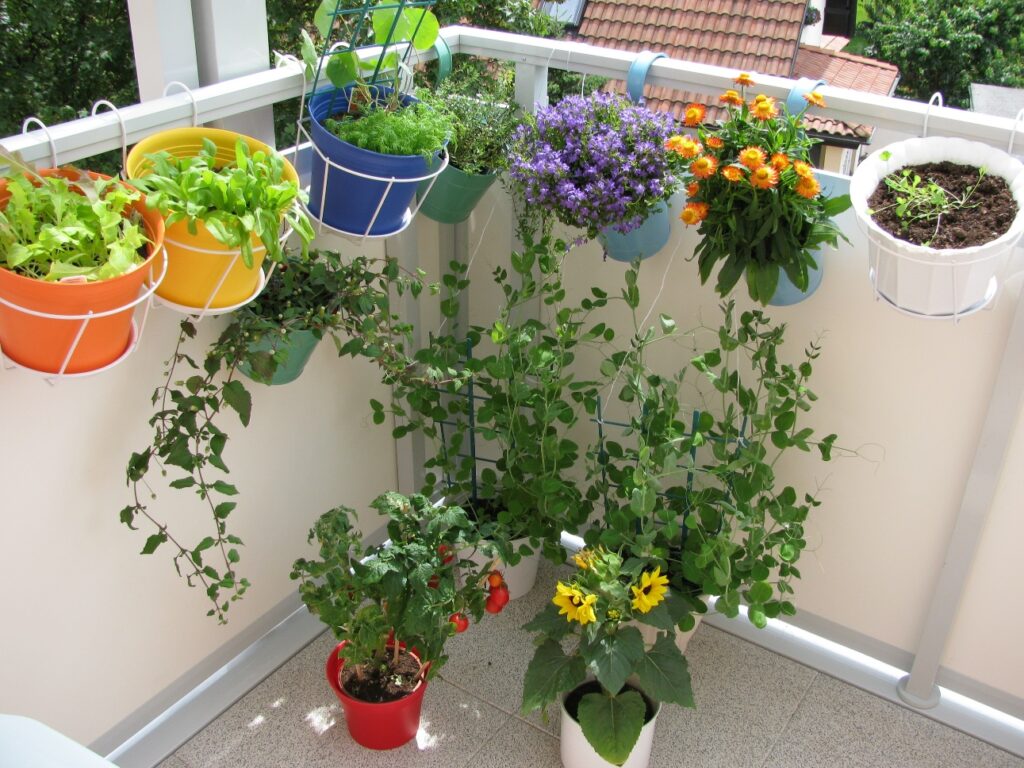
Attracting Birds and Butterflies to Balcony Garden
Your balcony garden can become a thriving oasis for local wildlife, even in urban areas. By incorporating the right plants and features, you can create a haven for birds and butterflies, adding life and color to your small space.
To attract butterflies, focus on planting brightly colored flowers with high nectar content. Butterflies are particularly drawn to pink, orange, purple, red, and yellow blooms. Consider adding plants like lantana, pentas, or zinnias to your balcony garden. These annuals are not only beautiful but also serve as excellent nectar sources for butterflies.
For a more permanent butterfly attraction, include perennials such as butterfly bush, coneflowers, or bee balm. These plants provide a reliable food source throughout the growing season. Don’t forget to include some host plants for caterpillars, such as milkweed for monarch butterflies.
To invite birds to your balcony, offer a variety of food sources. Hanging feeders are perfect for small spaces and can attract a range of bird species. Tube feeders filled with thistle seeds are great for attracting goldfinches and chickadees, while hopper feeders with sunflower seeds and cracked peanuts can draw in cardinals and blue jays.
Adding a small water source, like a shallow dish or hanging bird bath, can make your balcony even more appealing to birds. The sound of water can also help attract them to your space.
Maintaining Your Balcony Garden
Keeping your balcony garden thriving requires regular care and attention.
Regular Pruning and Harvesting
To keep your balcony garden looking its best, regular pruning is a must. Trim your plants to maintain their shape and size, especially in small spaces. For herbs and leafy vegetables, frequent harvesting encourages new growth and keeps plants productive. Snip off spent blooms from flowering plants to promote continuous flowering and maintain a tidy appearance.
Fertilizing Schedule
Fertilizing is crucial for container plants as nutrients in potting soil deplete quickly. Start with an all-purpose fertilizer about 2-6 weeks after planting. For flowering or fruiting plants, use a fertilizer higher in phosphorus and potassium. Apply a water-soluble fertilizer every 1-2 weeks, following package instructions. Alternatively, use slow-release fertilizers that feed plants for up to 120 days.
Pest Control
Keep an eye out for common balcony garden pests like aphids, mites, and caterpillars. Regularly inspect your plants and remove any pests by hand. For a natural approach, introduce beneficial insects like ladybugs to control pest populations. You can also use neem oil or insecticidal soap for more stubborn infestations.
Overwintering
As winter approaches, prepare your balcony garden for the cold months. Move tender plants indoors or to a sheltered area. For plants that stay outside, use frost cloth or burlap to protect them from freezing temperatures. Group containers together for added insulation and raise them slightly off the ground to improve drainage.
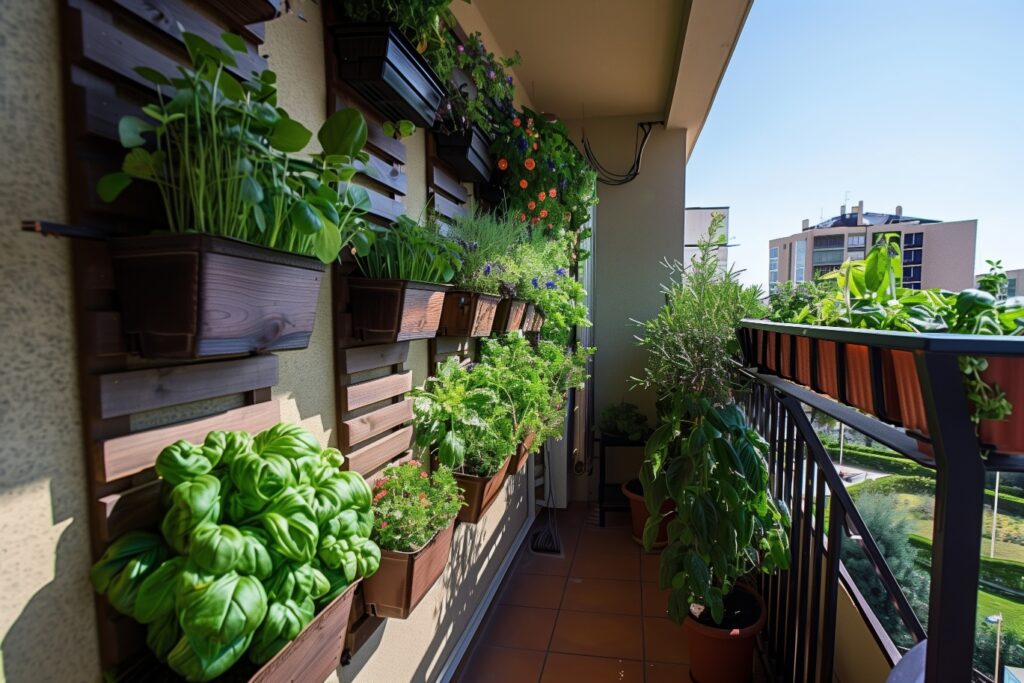
FAQs
What plants are best suited for balcony gardens?
Choose compact plants that thrive in containers. Herbs like basil, mint, and rosemary are excellent choices. For vegetables, try cherry tomatoes, lettuce, or peppers. Flowers such as petunias, marigolds, and geraniums add color and attract pollinators.
How do I maximize space in my balcony garden?
Utilize vertical space with hanging baskets, wall-mounted planters, or trellises. Stack containers of different sizes or use tiered planters. Consider multi-purpose furniture with built-in planters for efficient space use.
Can I grow fruits in my balcony garden?
Yes! Dwarf fruit trees like lemons or figs work well in large containers (region/climate dependent). Strawberries thrive in hanging baskets, while blueberries can be grown in pots. Ensure they receive adequate sunlight and choose self-pollinating varieties for better yields.

